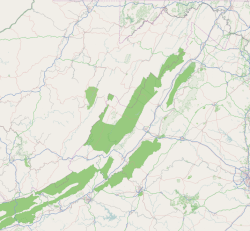
Florida Caverns State Park is a state park of Florida in the United States, part of the Florida State Parks system. It is located in the Florida Panhandle near Marianna. It is the only Florida state park with air-filled caves accessible to the public.

Craighead Caverns is an extensive cave system located in between Sweetwater and Madisonville, Tennessee. It is best known for containing the United States' largest and the world's second largest non-subglacial underground lake, The Lost Sea. In addition to the lake, the caverns contain an abundance of crystal clusters called anthodites, stalactites, stalagmites, and a waterfall.

California Cavern is a Limestone cave in the Sierra Nevada foothills, in Cave City, Calaveras County, California.
The Zane Shawnee Caverns is a cave system in Jefferson Township, Logan County, Ohio, United States. The caverns are show caves owned by the nonprofit United Remnant Band of the Shawnee Nation as of 1995.
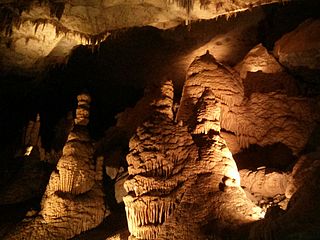
Cumberland Caverns is a national natural landmark and show cave located in McMinnville, Tennessee. It is the second longest cave in Tennessee and the twelfth longest cave in the United States.

Howe Caverns is a limestone solutional cave, operated as a show cave, in the hamlet of Howes Cave, Schoharie County, New York. Howe Caverns is a popular tourist attraction, providing visitors with a sense of caving or spelunking, without needing the advanced equipment and training usually associated with such adventures.

Moaning Caverns is a solutional cave located in the Calaveras County, California, near Vallecito, California in the heart of the state's Gold Country. It is developed in marble of the Calaveras Formation. It was discovered in modern times by gold miners in 1851, but it has long been known as an interesting geological feature by prehistoric peoples. It gets its name from the moaning sound that echoed out of the cave luring people to the entrance, however expansion of the opening to allow access for the public disrupted the sounds. The portion of the cave developed for tourists consists of a spacious vertical shaft 165 feet tall, which is descended by a combination of stairs and a unique 100-foot-high (30 m) spiral staircase built in the early 1900s. It is open to the public for walking tours and spelunking. Including the off-trail areas, the cave reaches a depth of 410 feet.
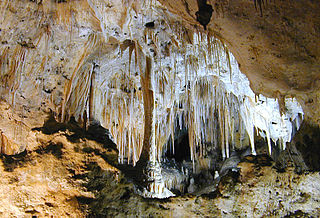
Carlsbad Caverns National Park is a national park of the United States in the Guadalupe Mountains of southeastern New Mexico. The primary attraction of the park is the show cave Carlsbad Cavern. Visitors to the cave can hike in on their own via the natural entrance or take an elevator from the visitor center.

Lost River Cave is a seven-mile cave system located in Bowling Green, Kentucky. The Lost River originates outside of the cave and flows into it. The cave contains one of the largest natural entrances in the Eastern U.S. Boat tours are available year-round, but closed for Thanksgiving Day, Christmas Eve, Christmas Day, and New Year's Day. The river was once listed by Ripley's Believe it or Not as the "Shortest, deepest river in the world" because the blue hole is over 437 feet deep, while the river itself is only 400 feet long. In fact, the blue hole is only 15 feet deep, but is linked to a further underground river. The 72-acre cave property is jointly owned by Western Kentucky University and the non-profit Friends of Lost River Cave.
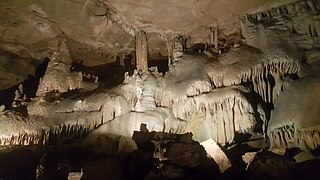
Raccoon Mountain Caverns is a cave located in Chattanooga, Tennessee in a band of Mississippian Period limestone, part of the Cumberland Plateau.

Onondaga Cave State Park is a Missouri state park located on the Meramec River approximately 5 miles (8.0 km) southeast of the village of Leasburg. The park was established in 1982. Park activities include cave tours, camping, fishing, hiking, picnicking, and swimming.

Boyden Cavern is a show cave located in the Giant Sequoia National Monument of the Sequoia National Forest, along the Kings Canyon Scenic Byway in Fresno County, California. It is just west of Kings Canyon National Park.

Aggtelek is a village in the county of Borsod-Abaúj-Zemplén, Hungary. It is known for the vast stalactite caverns of the nearby Baradla-Domica cave system, part of the UNESCO World Heritage Site of Aggtelek and Slovak Karst.
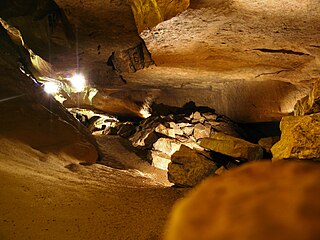
Seneca Caverns is a show cave located in northeastern Seneca County, Ohio, USA, just outside Flat Rock. The cave is designated as a Registered Natural Landmark by the Ohio Department of Natural Resources.
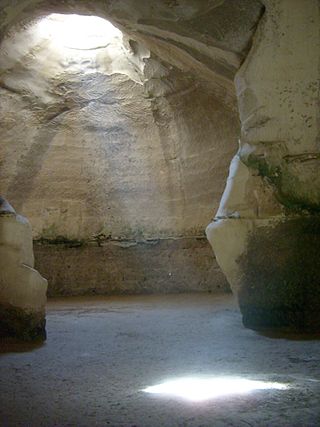
Beit Guvrin-Maresha National Park is a national park in central Israel, containing a large network of caves recognized by UNESCO as a World Heritage Site. The national park includes the remains of the historical towns of Maresha, one of the important towns of Judah during the First Temple Period, and Bayt Jibrin, a depopulated Palestinian town known as Eleutheropolis in the Roman era. However, Maresha and Bayt Jibrin are not part of the UNESCO site, which covers only the cave network.

The Grutas de Cacahuamilpa National Park in the Mexican state of Guerrero, Mexico, is best known for the Grutas de Cacahuamilpa Caverns. It is also home to the Grutas of Carlos Pacheco, a smaller system, as well as two subterranean rivers which have carved out tunnels in the rock. The park has outdoor pursuit attractions such as rappelling, and rock climbing in Limontitla Canyon. as well as the two underground rivers to explore. It also has a small botanical garden, a pool and places to camp.

Shenandoah Caverns is a commercial show cave located near Mount Jackson, Virginia, in the Shenandoah Valley and it is the only cavern in Virginia that has elevator access.

Kickapoo Cavern State Park is a state park straddling the Kinney and Edwards county line in Texas, located 22 miles north of Brackettville. The park is 6,368 acres (2,577 ha).

Ruakuri Cave is one of the longer caves in the Waitomo area of New Zealand. It was first discovered by local Māori between 400 and 500 years ago. The name Te Ruakuri, or "The Den of Dogs" was given to the surrounding area when wild dogs were discovered living in the entrance of the cave.

